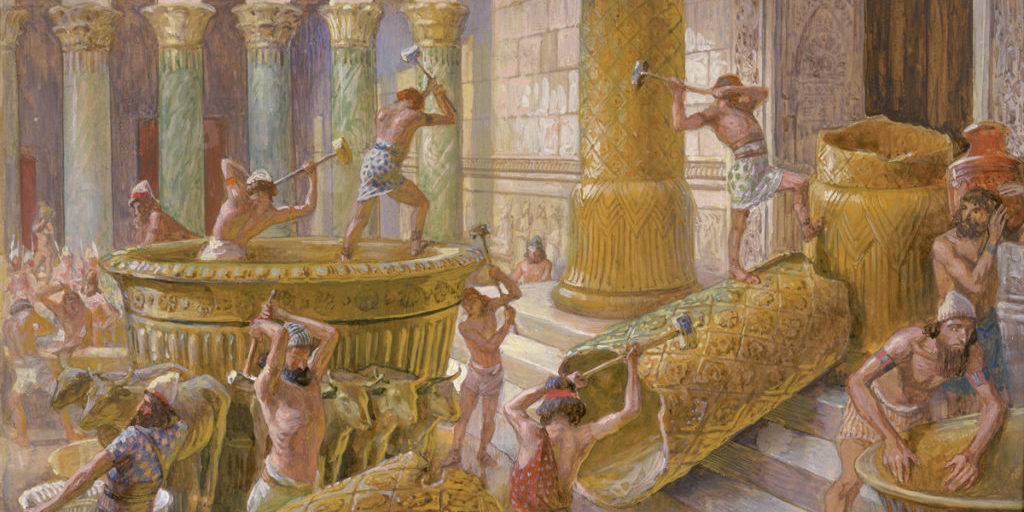
Signs of the Coming Salvation: Biblical Theology in Ezra, Nehemiah, and Esther
The ending of Nehemiah may be one of the most unsatisfying of any book in the Bible. But it actually makes an important contribution to biblical theology. An important key to understanding the theology of Ezra-Nehemiah (intended to be read as a single book and presented as such in the oldest manuscripts) is found in the reference to Jeremiah’s prophecy at the beginning of the narrative. Ezra 1:1 states that the events about to be described are related to the fulfillment of Jeremiah’s words. The author of Ezra-Nehemiah does not quote any passages, so the original readers were evidently familiar enough with what Jeremiah had said that they understood the significance of this allusion. Modern readers, however, may need to find out what Jeremiah said.
most unsatisfying of any book in the Bible. But it actually makes an important contribution to biblical theology. An important key to understanding the theology of Ezra-Nehemiah (intended to be read as a single book and presented as such in the oldest manuscripts) is found in the reference to Jeremiah’s prophecy at the beginning of the narrative. Ezra 1:1 states that the events about to be described are related to the fulfillment of Jeremiah’s words. The author of Ezra-Nehemiah does not quote any passages, so the original readers were evidently familiar enough with what Jeremiah had said that they understood the significance of this allusion. Modern readers, however, may need to find out what Jeremiah said.
In Jeremiah 25 God tells Judah that because the people have not listened to his words their land will be destroyed by the king of Babylon and they will become his subjects (vv. 8–11). This state of affairs will last seventy years. At the end of that period, however, the king of Babylon and his nation will themselves be subjected to others for their wicked deeds (vv. 12–14). God later adds that when the period of Babylonian domination ends he will bring those who have been exiled back to the land of Judah (29:10–14). This promise introduces a phrase that recurs several times in Jeremiah that can be translated, “reverse the plight” (NET, v. 14), or “restore the fortunes” (CSB, ESV, NJPS, NRSV). This phrase typically means “to reestablish a state of affairs as it was,” implying that a situation that has become bad will improve to how it was before (footnote HALOT 1386, 3.c).[1] The phrase reappears in Jeremiah in contexts where the Lord describes further what the restoration of Judah will be like (30:3, 18; 31:23; 32:44; 33:7, 11). Thus, Jeremiah 25–33 creates the expectation that the Babylonians will come to Judah, destroy the Jerusalem temple, lay waste to the land, kill many inhabitants, and take many others away into exile but also that after seventy years the Babylonians will be overthrown, the exiled Judeans will be allowed to return to Judah, and the Lord will restore the blessings they previously enjoyed.
Aspects of this restoration correspond to much of what the reader finds described in Ezra-Nehemiah. The return of Judean exiles to Judah, the rebuilding of the temple in Jerusalem, the reconstruction of Jerusalem’s wall, and the reinstitution of the worship of the Lord all agree with the expectations created by Jeremiah. But to fully understand the connection the writer of Ezra-Nehemiah sees with Jeremiah’s prophecy, another component of the prophecy must be observed.
The oracles of restoration in Jeremiah 30–33 include a promise that after the days of judgment the Lord will make a new covenant with Israel and Judah (31:31–34). An important element of this covenant is God putting his law directly into the hearts and minds of his people, with the result that they will acknowledge his sovereignty and commit whole-heartedly to obeying him (vv. 33–34).[2] The narrator of Ezra-Nehemiah expects his readers to be familiar with this promise and to anticipate that it will be fulfilled along with other aspects of the restoration. Parts of the narrative provide hope that the returned exiles may indeed be experiencing its fulfillment. The community approaches Ezra about correcting the intermarriages even before any mention of Ezra teaching them the Law (Ezra 9:1–2). The community asks for the Law to be read to them and responds to the reading with rejoicing and diligent obedience (Neh. 8). They participate in an extended prayer of repentance of past sin (Neh. 9) and pledge to be obedient to the Lord henceforth (Neh. 10).
Yet the narrative also describes many ethical and spiritual shortcomings in the community. Ezra 9 describes how the Israelites living in the land have become involved in intermarriage with those outside Israel. Even after Ezra’s repentant prayer and the decision at the beginning of Ezra 10 to dissolve the offending marriages, the episode ends with ambiguity about the level of compliance among the community. Nehemiah 6:17–19 notes how the loyalty of the Jewish aristocracy is divided between Nehemiah and the enemies of the Jews. And the final chapter of Nehemiah relates how, in Nehemiah’s absence, the community allowed the temple area to be desecrated, the grain offerings for Levites to lapse, labor and commerce to take place on the Sabbath, and more intermarriage with foreign women.
The extent to which the new covenant prophecy can be seen as fulfilled, then, is significantly limited. It has begun, but the complete realization of the promise seems yet to be in the future. This seems to be the impression that the narrator of Ezra-Nehemiah intended to leave. The historical events selected for inclusion, when compared with Jeremiah’s prophecy, provide clear evidence of the fulfillment of some aspects of the promises contained in Jeremiah 25–33 but also equally clear evidence that not all aspects have reached the fulfillment promised. Many Christians are familiar from the New Testament with the concept of the partial but incomplete fulfillment of prophecy. The life, death, resurrection, and ascension of Christ, and the nature and activities of the early church constitute a fulfillment of many Old Testament prophecies about the coming kingdom of God. Yet many of these same prophecies await a further degree of fulfillment at Christ’s return. It may surprise some contemporary readers that the phenomenon of “already-but-not-yet-fulfilled” prophecy can be seen already in the Old Testament itself.
These insights help the reader to fit Ezra-Nehemiah into the flow of biblical theology. The narrative proclaims that the end of Babylonian rule has come (King Cyrus is a Persian, Ezra 1:1), signaling the beginning of the time of restoration for the exiles of Israel. Much progress is made in restoring the fortunes of the captives as individuals and the nation as a whole. Even a new zeal to be faithful to the Lord comes into view. But the comprehensive achievement of God’s plans for his people remains in the future, requiring the appearance of the Messiah, foretold in other parts of the Old Testament, and of whom nothing is reported in Ezra-Nehemiah. Understanding this helps the reader to identify important principles in Ezra-Nehemiah about being faithful while waiting for the ultimate fulfillment of God’s promises, principles still very relevant today.
Esther
It is well known that Martin Luther had doubts about whether Esther should be considered canonical, and he apparently expressed concerns about its theology. Yet a close look at the elements of its story yields some significant connections to the New Testament that modern readers may find surprising. God is able to take the evilest of schemes intended to inflict destruction and shame and reverse expectations by using it to save his people. Click To Tweet
When Haman is introduced in 3:1, he is identified as an Agagite. This reminds readers of the Amalekite king by that name from 1 Samuel 15. Amalekites were perpetual enemies of Israel, and it is made explicit that this is Haman’s disposition in Esther 3:10. Unsurprisingly, Haman hatches a plot to annihilate the Jews (vv. 8–9). The particular focus of his anger is one of them in particular, Mordecai, who will not bow to him (vv. 5–6), and whom he plans to hang on a gallows (Heb. “tree” or “wood”; 5:9–14). But Haman’s plan backfires. When the king learns that Haman has built a gallows for Mordecai, the king orders that Haman himself be hanged on it (7:9–10). After this point, the story moves consistently toward the rescue of the Jews from destruction.
Of course, the better-known story in the Bible in which the enemy of God’s people seeks to destroy them and to pour out his anger especially on one who refuses to bow to him, arranging to hang him from a tree, only to have the plan backfire, resulting in the enemy’s own destruction and leading to the salvation of God’s people, is found in the Gospels. But this is one of the most powerful examples in the Old Testament of the principle that God is able to take the evilest of schemes intended to inflict destruction and shame (a person whose body is left hanging on a tree is considered cursed by God, Deut. 21:23) and reverse expectations by using it to save his people. In this sense, Esther lays the groundwork for an important feature of New Testament theology.
Endnotes
[1] “ŝebȗt,” in Ludwig Koehler, Walter Baumgartner, and M. E. J. Richardson, eds., The Hebrew and Aramaic Lexicon of the Old Testament (Leiden: Brill, 1994-2000), 1386.
[2] The Hebrew phrase “to know Yahweh,” as used here and other covenant contexts such as Jer. 9:3, typically involves more than a mere awareness of who he is. Throughout Hos. 4:1–6, disobeying God’s commands is equated with not knowing him.

